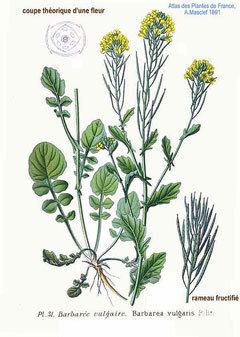Scientific name Barbarea vulgaris Rank Species | ||
 | ||
Similar Barbarea, Cabbage family, Alliaria, Cardamine, Thlaspi arvense | ||
Barbarea vulgaris, also called bittercress, herb barbara, rocketcress, yellow rocketcress, winter rocket, and wound rocket, is a biennial herb of the genus Barbarea, belonging to the mustard family.
Contents
Etymology
The genus name Barbarea derives from Saint Barbara, the patron saint of artillerymen and miners, as this plant in the past was used to soothe the wounds caused by explosions. The species Latin name vulgaris means “common”.
Description
This plant grows to about 30–60 cm (12–24 in) high, with a maximum of 1 m (3 ft 3 in). The stem is ribbed and hairless, branched at the base. It has a basal rosettes of shiny, dark green leaves. The basal leaves are stalked and lyre-pinnatifid, that is with a large terminal lobe and smaller lower lobes. The cauline leaves are smaller, ovate, toothed, or lobed. The flowers are borne in spring in dense terminal clusters above the foliage. They are 7–9 mm (0.28–0.35 in) long, with four bright yellow petals. The flowering period extends from about April through July. The fruit is a pod around 15–30 mm (0.59–1.18 in).
Chemical substances in this species include saponins, flavonoids, and glucosinolates.
Natural insect resistance and its potential use in agriculture
Most B. vulgaris genotypes are naturally resistant to some insect species that are otherwise specialized on the crucifer family. In the case of diamondback moth (Plutella xylostella) and the flea beetle Phyllotreta nemorum, the resistance is caused by saponins. Glucosinolates such as glucobarbarin and glucobrassicin are used as a cue for egg-laying by female cabbage white butterflies such as Pieris rapae. Indeed, the larvae of this butterfly thrive well on this plant. Diamondback moth females are also stimulated by these chemicals, but the larvae die due to the content of saponins which are apparently not sensed by the moths. This phenomenon has been tested for biological insect control: B. vulgaris plants are placed in a field and attract much of the diamondback moth egg load. As the larvae die shortly after hatching, this kind of insect control has been named "dead-end trap cropping".
Distribution
Native to Eurasia, it is naturalised in many parts of North America as a weed.
Habitat
The plant prefers fresh or moist places, on roadsides, along rivers, or on the slopes and in ditches, at an altitude of 0–1,600 m (0–5,249 ft) above sea level.
Natural chemotypes with distinct ecology
A pubescent type (the "P-type") has been described from southern Scandinavia. This type has atypical chemistry and is devoid of resistance to the diamondback moth and the flea beetle Phyllotreta nemorum. The P-type belongs morphologically to the variety B. vulgaris var. arcuata, but may also be identical to the subspecies originally described as Barbaraea Beck arcuata Rchb. ssp. pubescens N. Busch. In this context, the usual type of B. vulgaris var. arcuata is called the "G-type" (for glabrous (hairless) leaves).
A chemotype with deviating glucosinolate content has been described from Western Europe and named the "NAS-type" (because it is dominated by the glucosinolate glucoNASturtiin. This type has increased resistance to some specialized insects. In this context, the usual chemotype of B. vulgaris is called the "BAR" type (because it is dominated by glucoBARbarin).
